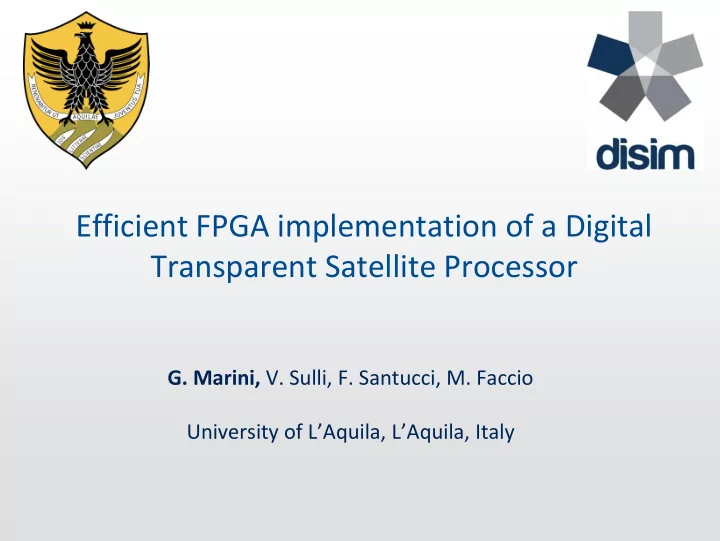

Efficient FPGA implementation of a Digital Transparent Satellite Processor G. Marini, V. Sulli, F. Santucci, M. Faccio University of L’Aquila, L’Aquila, Italy
Outline • Introduction • Problem Definition • Resolution Method • FPGA Implementation • Results • Conclusion • Future Work 2
Introduction(1) In satellite systems for telecommunications a great deal of interest concerns the mesh topology [Mesh topology] 3
Introduction(2) Four alternatives for the architecture of a satellite transponder : • Fully transparent payload • Fully regenerative payload • Digital transparent payload • Digital Semi-transparent payload 4
Introduction(3) Four alternatives for the architecture of a satell ite transponder : • Fully transparent payload • Fully regenerative payload • Digital transparent payload • Digital Semi-transparent payload Digital Transparent Processor (DTP) is involved 5
Introduction(4) Four alternatives for the architecture of a satell ite transponder : • Fully transparent payload • Fully regenerative payload • Digital transparent payload • Digital Semi-transparent payload • Support of mesh networking Digital Transparent Processor • Flexibility in the routing (DTP) is involved • Frequency planning flexibility 6
Introduction(5) Scenario of interest: • 79 beams (with 125 MHz allocated per beam) with fully connectivity and flexible routing in frequency, time spatial domains 7
Introduction(6) In this context the digital semi-transparent payloads have been recently devised and investigated 8
Problem Definition(1) • A digital transparent/semi-transparent satellite payload can be see as a hybrid analog-digital on-board chain • Modelling and design approaches have so far almost missed the ability to capture in an adequate way these important features 9
Problem Definition(2) Problem: To provide a method that, given the link-budget requirement, provides a detailed definition of digital HW components in the DTP 10
Resolution Method(1) Step 1 : • Define a System Model of DTP-based Transponder A DTP processing chain is composed by: • P 0 : ADC • P 1 : Analytical signal extrapolation • P 2 : Channalizer (analysis) • Switching • P 3 : Channalizer (synthesis) • P 4 : IF signal extrapolation • P 5 : DAC 11
Resolution Method(2) Step 2 : • Develop an equivalet noise model for the whole DTP chain to understand how link level performance (the DTP noise figure) may impact on the DTP hardware complexity 12
Resolution Method(3) Step 3 : • Computing the hardware complexity in terms of: i. Number of 2-words multipliers ii. Number of 2-words adders iii.Number of Flip-Flops iv.Number of ROM bits 13
FPGA Implementation(1) The DTP is composed by three basic blocks: • FIR filter elements, implemented in direct form 14
FPGA Implementation(2) The DTP is composed by three basic blocks: • FIR filter elements, implemented in direct form • FFT/IFFT butterfly structures 15
FPGA Implementation(3) The DTP is composed by three basic blocks: • FIR filter elements, implemented in direct form • FFT/IFFT butterfly structures • RAM buffers 16
Results(1) To the increase of DTP Noise Figure corresponds a degradation in the link performance show as reduction in the Additional Margin at the ground receiver 17
Results(2) The DTP Hardware complexity may be directly linked to the chosen working point 18
Results(3) For a given DTP Noise Figure, different hard- ware complexity can be obtained by applying different design approaches, e.g.: • • UC: Uniform Contributions UP: Uniform Parameters • • TO: Trade-Off MR: Minimum RAM 19
Conclusion • We have developed a comprehensive framework for hardware complexity evaluation of novel satellite payloads that rely on semi-transparent transponder architectures • The DTP complexity has been related to the overall processed bandwidth, the selected coding and modulation formats, and performance degradation requirements 20
Future Work • Definition of an optimized criterion for DTP hardware design • Adaptations of the developed framework to several scenarios of interest in satellite communications 21
Thanks 22
Recommend
More recommend